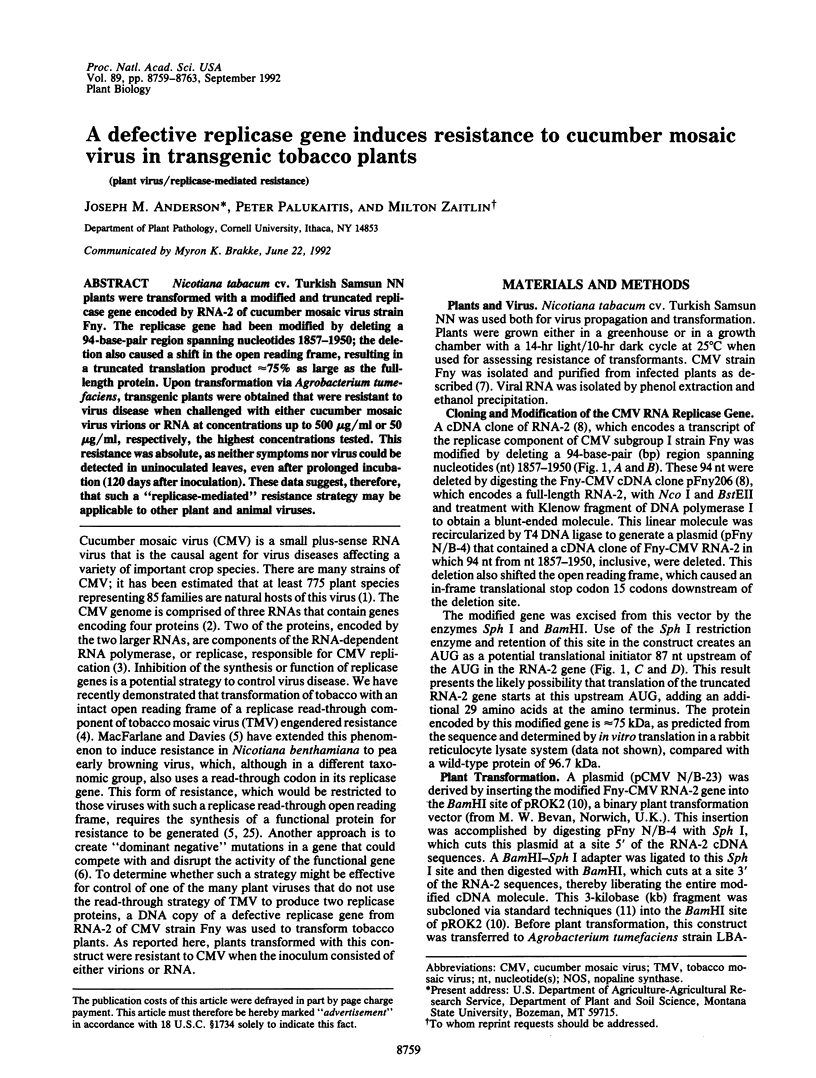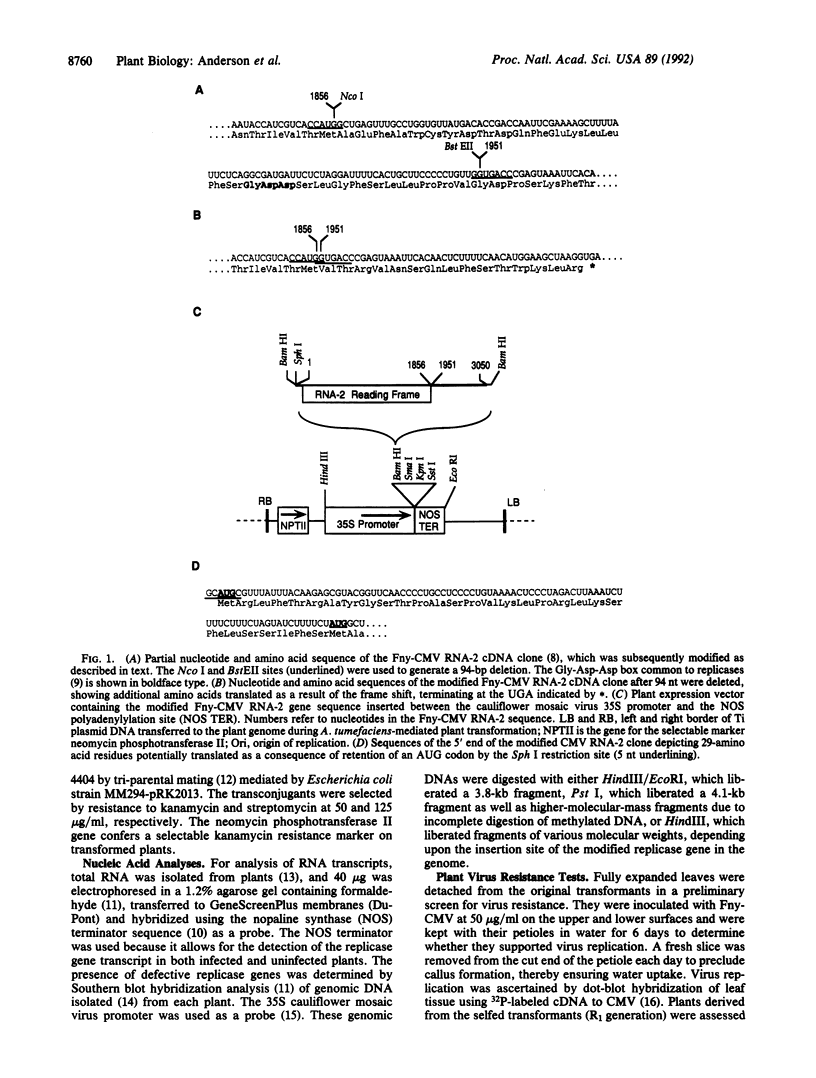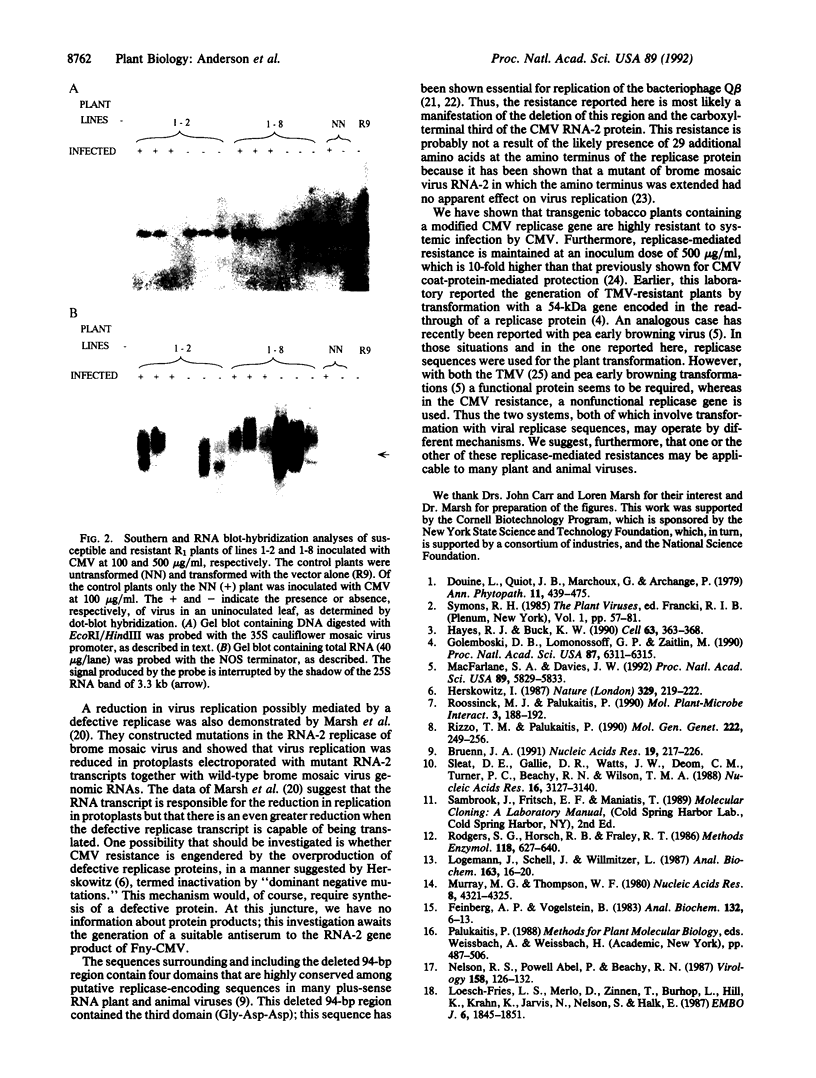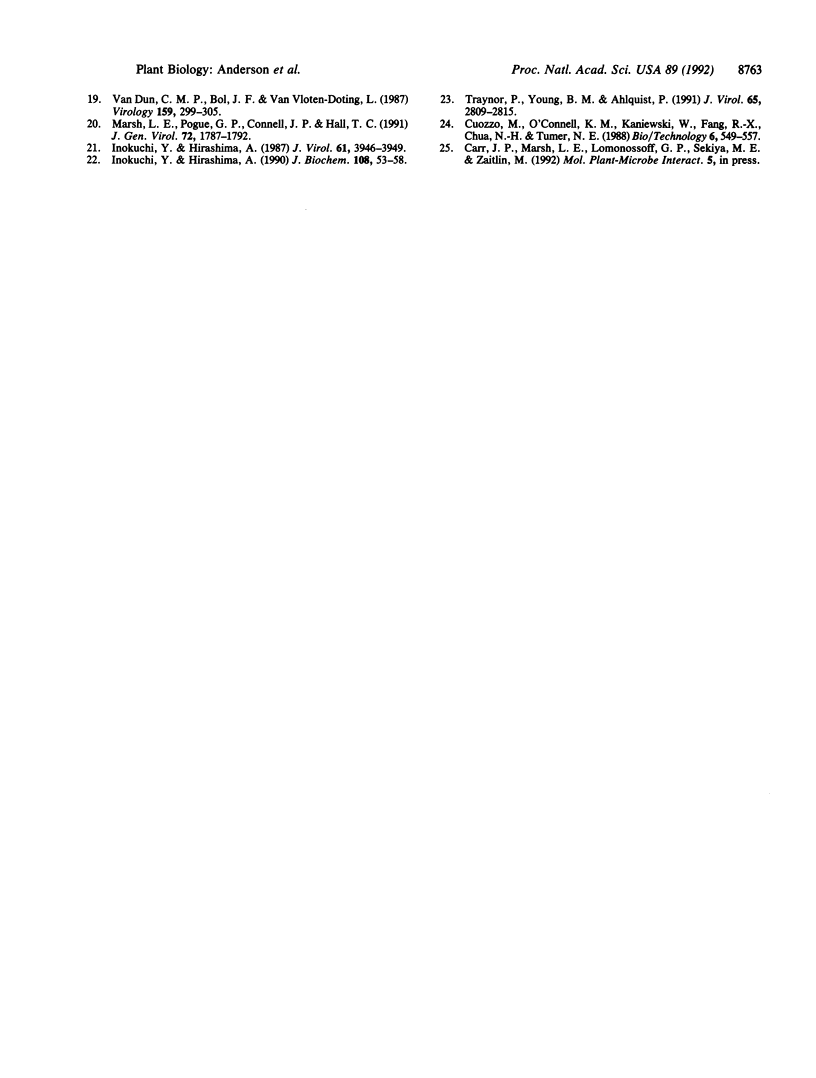Abstract
Nicotiana tabacum cv. Turkish Samsun NN plants were transformed with a modified and truncated replicase gene encoded by RNA-2 of cucumber mosaic virus strain Fny. The replicase gene had been modified by deleting a 94-base-pair region spanning nucleotides 1857-1950; the deletion also caused a shift in the open reading frame, resulting in a truncated translation product approximately 75% as large as the full-length protein. Upon transformation via Agrobacterium tumefaciens, transgenic plants were obtained that were resistant to virus disease when challenged with either cucumber mosaic virus virions or RNA at concentrations up to 500 micrograms/ml or 50 micrograms/ml, respectively, the highest concentrations tested. This resistance was absolute, as neither symptoms nor virus could be detected in uninoculated leaves, even after prolonged incubation (120 days after inoculation). These data suggest, therefore, that such a "replicase-mediated" resistance strategy may be applicable to other plant and animal viruses.
Full text
PDF




Images in this article
Selected References
These references are in PubMed. This may not be the complete list of references from this article.
- Bruenn J. A. Relationships among the positive strand and double-strand RNA viruses as viewed through their RNA-dependent RNA polymerases. Nucleic Acids Res. 1991 Jan 25;19(2):217–226. doi: 10.1093/nar/19.2.217. [DOI] [PMC free article] [PubMed] [Google Scholar]
- Feinberg A. P., Vogelstein B. A technique for radiolabeling DNA restriction endonuclease fragments to high specific activity. Anal Biochem. 1983 Jul 1;132(1):6–13. doi: 10.1016/0003-2697(83)90418-9. [DOI] [PubMed] [Google Scholar]
- Golemboski D. B., Lomonossoff G. P., Zaitlin M. Plants transformed with a tobacco mosaic virus nonstructural gene sequence are resistant to the virus. Proc Natl Acad Sci U S A. 1990 Aug;87(16):6311–6315. doi: 10.1073/pnas.87.16.6311. [DOI] [PMC free article] [PubMed] [Google Scholar]
- Hayes R. J., Buck K. W. Complete replication of a eukaryotic virus RNA in vitro by a purified RNA-dependent RNA polymerase. Cell. 1990 Oct 19;63(2):363–368. doi: 10.1016/0092-8674(90)90169-f. [DOI] [PubMed] [Google Scholar]
- Herskowitz I. Functional inactivation of genes by dominant negative mutations. Nature. 1987 Sep 17;329(6136):219–222. doi: 10.1038/329219a0. [DOI] [PubMed] [Google Scholar]
- Inokuchi Y., Hirashima A. Interference with viral infection by RNA replicase deleted at the carboxy-terminal region. J Biochem. 1990 Jul;108(1):53–58. doi: 10.1093/oxfordjournals.jbchem.a123162. [DOI] [PubMed] [Google Scholar]
- Inokuchi Y., Hirashima A. Interference with viral infection by defective RNA replicase. J Virol. 1987 Dec;61(12):3946–3949. doi: 10.1128/jvi.61.12.3946-3949.1987. [DOI] [PMC free article] [PubMed] [Google Scholar]
- Loesch-Fries L. S., Merlo D., Zinnen T., Burhop L., Hill K., Krahn K., Jarvis N., Nelson S., Halk E. Expression of alfalfa mosaic virus RNA 4 in transgenic plants confers virus resistance. EMBO J. 1987 Jul;6(7):1845–1851. doi: 10.1002/j.1460-2075.1987.tb02442.x. [DOI] [PMC free article] [PubMed] [Google Scholar]
- Logemann J., Schell J., Willmitzer L. Improved method for the isolation of RNA from plant tissues. Anal Biochem. 1987 May 15;163(1):16–20. doi: 10.1016/0003-2697(87)90086-8. [DOI] [PubMed] [Google Scholar]
- MacFarlane S. A., Davies J. W. Plants transformed with a region of the 201-kilodalton replicase gene from pea early browning virus RNA1 are resistant to virus infection. Proc Natl Acad Sci U S A. 1992 Jul 1;89(13):5829–5833. doi: 10.1073/pnas.89.13.5829. [DOI] [PMC free article] [PubMed] [Google Scholar]
- Marsh L. E., Pogue G. P., Connell J. P., Hall T. C. Artificial defective interfering RNAs derived from brome mosaic virus. J Gen Virol. 1991 Aug;72(Pt 8):1787–1792. doi: 10.1099/0022-1317-72-8-1787. [DOI] [PubMed] [Google Scholar]
- Murray M. G., Thompson W. F. Rapid isolation of high molecular weight plant DNA. Nucleic Acids Res. 1980 Oct 10;8(19):4321–4325. doi: 10.1093/nar/8.19.4321. [DOI] [PMC free article] [PubMed] [Google Scholar]
- Rizzo T. M., Palukaitis P. Construction of full-length cDNA clones of cucumber mosaic virus RNAs 1, 2 and 3: generation of infectious RNA transcripts. Mol Gen Genet. 1990 Jul;222(2-3):249–256. doi: 10.1007/BF00633825. [DOI] [PubMed] [Google Scholar]
- Sleat D. E., Gallie D. R., Watts J. W., Deom C. M., Turner P. C., Beachy R. N., Wilson T. M. Selective recovery of foreign gene transcripts as virus-like particles in TMV-infected transgenic tobaccos. Nucleic Acids Res. 1988 Apr 25;16(8):3127–3140. doi: 10.1093/nar/16.8.3127. [DOI] [PMC free article] [PubMed] [Google Scholar]
- Traynor P., Young B. M., Ahlquist P. Deletion analysis of brome mosaic virus 2a protein: effects on RNA replication and systemic spread. J Virol. 1991 Jun;65(6):2807–2815. doi: 10.1128/jvi.65.6.2807-2815.1991. [DOI] [PMC free article] [PubMed] [Google Scholar]



